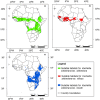Variable intraspecific response to climate change in a medicinally important African tree species, Vachellia sieberiana (DC.) (paperbark thorn)
- PMID: 38694755
- PMCID: PMC11056962
- DOI: 10.1002/ece3.11314
Variable intraspecific response to climate change in a medicinally important African tree species, Vachellia sieberiana (DC.) (paperbark thorn)
Abstract
Climate change is predicted to disproportionately impact sub-Saharan Africa, with potential devastating consequences on plant populations. Climate change may, however, impact intraspecific taxa differently. The aim of the study was to determine the current distribution and impact of climate change on three varieties of Vachellia sieberiana, that is, var. sieberiana, var. villosa and var. woodii. Ensemble species distribution models (SDMs) were built in "biomod2" using 66, 45, and 137 occurrence records for var. sieberiana, var. villosa, and var. woodii, respectively. The ensemble SDMs were projected to 2041-2060 and 2081-2100 under three general circulation models (GCMs) and two shared socioeconomic pathways (SSPs). The three GCMs were the Canadian Earth System Model version 5, the Institut Pierre-Simon Laplace Climate Model version 6A Low Resolution, and the Model for Interdisciplinary Research on Climate version 6. The suitable habitat of var. sieberiana predominantly occurs in the Sudanian and Zambezian phytochoria while that of var. villosa largely occurs in the Sudanian phytochorion. The suitable habitat of var. woodii mainly occurs in the Zambezian phyotochorion. There is coexistence of var. villosa and var. sieberiana in the Sudanian phytochorion while var. sieberiana and var. woodii coexist in the Zambezian phytochorion. Under SSP2-4.5 in 2041-2060 and averaged across the three GCMs, the suitable habitat expanded by 33.8% and 119.7% for var. sieberiana and var. villosa, respectively. In contrast, the suitable habitat of var. woodii contracted by -8.4%. Similar trends were observed in 2041-2060 under SSP5-8.5 [var. sieberiana (38.6%), var. villosa (139.0%), and var. woodii (-10.4%)], in 2081-2100 under SSP2-4.5 [var. sieberiana (4.6%), var. villosa (153.4%), and var. woodii (-14.4%)], and in 2081-2100 under SSP5-8.5 [var. sieberiana (49.3%), var. villosa (233.4%), and var. woodii (-30.7%)]. Different responses to climate change call for unique management and conservation decisions for the varieties.
Keywords: Vachellia sieberiana; climate change; conservation; ensemble species distribution model; shared socioeconomic pathway; species variety.
© 2024 The Authors. Ecology and Evolution published by John Wiley & Sons Ltd.
Conflict of interest statement
The authors have no relevant financial or non‐financial interests to disclose.
Figures




Similar articles
-
Predicting climate change impacts on vereda wetland plant species distribution in the Brazilian Cerrado.Ann Bot. 2025 Jun 10:mcaf120. doi: 10.1093/aob/mcaf120. Online ahead of print. Ann Bot. 2025. PMID: 40491138
-
What is in a name? Scientific name changes of potentially poisonous plants and fungi in South Africa.J S Afr Vet Assoc. 2022 Nov;93(2):76-81. doi: 10.36303/JSAVA.160. Epub 2022 Jun 16. J S Afr Vet Assoc. 2022. PMID: 35934904 Review.
-
Differential patterns of nitrogen nutrition and growth cost of the indigenous Vachellia sieberiana and the introduced Chromolaena odorata in the savannah environment.AoB Plants. 2019 Feb 27;11(3):plz008. doi: 10.1093/aobpla/plz008. eCollection 2019 Jun. AoB Plants. 2019. PMID: 31198527 Free PMC article.
-
Prediction of the Potential Distribution of the Endangered Species Meconopsis punicea Maxim under Future Climate Change Based on Four Species Distribution Models.Plants (Basel). 2023 Mar 20;12(6):1376. doi: 10.3390/plants12061376. Plants (Basel). 2023. PMID: 36987063 Free PMC article.
-
Decline in the suitable habitat of dominant Abies species in response to climate change in the Hindu Kush Himalayan region: insights from species distribution modelling.Environ Monit Assess. 2022 Jul 21;194(9):596. doi: 10.1007/s10661-022-10245-y. Environ Monit Assess. 2022. PMID: 35861887
Cited by
-
Advancements in ecological niche models for forest adaptation to climate change: a comprehensive review.Biol Rev Camb Philos Soc. 2025 Aug;100(4):1754-1781. doi: 10.1111/brv.70023. Epub 2025 Apr 3. Biol Rev Camb Philos Soc. 2025. PMID: 40181243 Free PMC article. Review.
References
-
- Aarssen, L. W. (1983). Ecological combining ability and competitive combining ability in plants: Toward a general evolutionary theory of coexistence in systems of competition. The American Naturalist, 122, 707–731. 10.1086/284167 - DOI
-
- Aarssen, L. W. (1984). On the distinction between niche and competitive ability: Implications for coexistence theory. Acta Biotheoretica, 33, 67–83. 10.1007/BF00052146 - DOI
-
- Affoh, R. , Zheng, H. , Dangui, K. , & Dissani, B. M. (2022). The impact of climate variability and change on food security in sub‐Saharan Africa: Perspective from panel data analysis. Sustainability, 14, 759. 10.3390/su14020759 - DOI
-
- Aiello‐Lammens, E. M. , Boria, A. R. , Radosavljevic, A. , Vilela, B. , & Anderson, P. R. (2015). spThin: An R package for spatial thinning of species occurrence records for use in ecological niche models. Ecography, 38, 541–545. 10.1111/ecog.01132 - DOI
LinkOut - more resources
Full Text Sources
Miscellaneous

